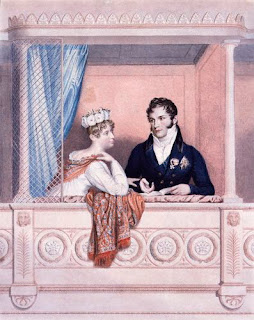Saturday, June 11, 2011, was not only the Trooping of the Colour (see my post of 7/30/11). It was the first day of the Open Squares weekend. Being an unabashed Nosey Parker, I love this time when many of the private squares and parks in London are opened to the public.
| Garden at Carlton House Terrace |
While the Queen was reviewing her troops on the parade ground at Horse Guards, I wandered to a few of the gardens in the vicinity of St. James.
| Marlborough House, St. James You can take an excellent virtual tour of the interior and exterior of the house here. Marlborough House is now the home of the Commonwealth Secretariat and the Commonwealth Foundation. In learning more about Marlborough House, I found it was associated with a large number of remarkable people, particularly women. The house was built on land leased from the crown adjoining St. James Palace for Sarah Churchill, 1st Duchess of Marlborough, who was a close friend of and adviser to Queen Anne. Sarah, Duchess of Marlborough (1660-1744) National Portrait Gallery Sarah chose as architect Sir Christopher Wren. She disliked Sir John Vanbrugh who was building Blenheim, the magnificent baroque country house in Oxfordshire which was to be a gift of a grateful nation to the 1st Duke of Marlborough for his victory in the Battle of Blenheim in 1704. The Original Marlborough House
Sarah wanted a plain and convenient house, without florid embellishments; in her own words, “…unlike anything at Blenheim.” She laid the foundation cornerstone in 1709, but she quarreled with and later dismissed Wren. The feisty duchess took over the supervision of Marlborough House’s completion. Like her disputes with the Blenheim builders, the economical and thrifty Sarah refused to give in to excessive costs and overcharging. Sir Christopher Wren (1632-1723) |
Wren’s original design was dramatically altered in 1770 when a third floor and additional wings were added.
The Marlborough family occupied the house until 1817 when the property reverted to the Crown. Marlborough House was being prepared to be the London home of Princess Charlotte and her husband Prince Leopold with their expected child when the Princess died in childbirth in November, 1817, putting the entire country into mourning.
 |
| Charlotte and Leopold, c. 1816 |
Leopold did occupy Marlborough House and lived there until he became King of Belgium in 1831. He was not only the widower of Princess Charlotte; he was the brother of the Duchess of Kent and uncle to Princess Victoria. Marlborough House was next presented to Queen Adelaide, consort of William IV, for her use.
 |
| Adelaide of Saxe-Meiningen, Queen of England (1792-1849) |
Adelaide, the first dowager queen for almost 150 years, did not spend a great deal of time at Marlborough House. She was viewed with suspicion by the Duchess of Kent and other advisors to the young Queen Victoria, and thus spent more time in the country wandering from one rented house to another.
Years later, a collection of artifacts from the Great Exposition of 1851 was displayed to the public in Marlborough House, making it a museum of arts and science. It’s success led to Queen Victoria and Prince Albert deciding to build permanent displays on a grand scale, which became the Science Museum, the Natural History Museum, and the Victoria and Albert Museum in Kensington.
After a period of time when it was used as a national art school, the building was remodeled as a home for the Prince of Wales, later Edward VII (1841-1910), and his wife Alexandra of Denmark. Further additions were made before the couple moved in. Their active social life led to the fame of the Marlborough House Set, a circle of fashionable aristocrats as well as a few who were not very aristocratic at all. But no doubt amusing!
Anita Leslie’s 1973 book about this Eawardian group makes fascinating reading. George V was born here in 1903. After Queen Victoria died, Bertie (having lived for decades as Prince of Wales) reigned only only nine years as Edward VII. Another dowager queen, Alexandra moved back to Marlborough House, where she lived until her death in 1925.
 |
| Queen Alexandra |
To return to my visit to the Marlborough House Garden, I enjoyed a cup of tea and sat on a damp bench — the weather was cool and occasionally it tried to rain, but I believe that is not allowed on the day of Trooping the Colour, so it always blew away in a short time.
The Garden brochure says, “The garden has been largely maintained in its original formal 18th-century layout, with a number of large, plain expanses of lawn, intersected by gravel pathways.” Flowers and hedges were restricted to the boundaries, but at the eastern end, there is a shrubbery with a woodland path where I found the pet cemetery.
A row of little headstones marks the final resting point for some of Alexandra’s most beloved pets.
On several of the stones there were pictures of the little dogs, which looked like King Charles spaniels, with their mistress.
As I walked around the garden, I realized that the bands I heard were right outside the wall as the troops returned to Buckingham Palace from Trooping the Colour. A little cluster of us peered over the wall and watched the parade.
A final view of Marlborough House.
Memorial to Queen Alexandra just outside Marlborough House where she lived much of her life. It was designed by Sir Alfred Gilbert and dedicated in 1932 by George V, Queen Alexandra’s son.




Thanks for sharing a wonderful place to see here. Marlborough House is great place to watch it. My friend has been travel at these place. He share some good experience of traveling over these place. It really like these place very much. It is too old.